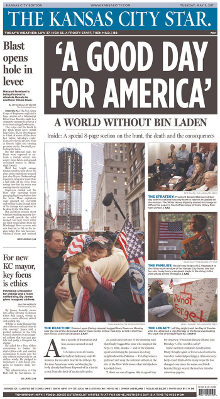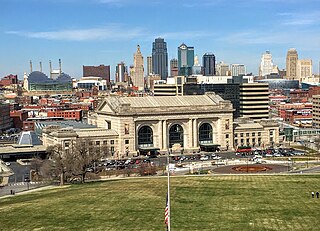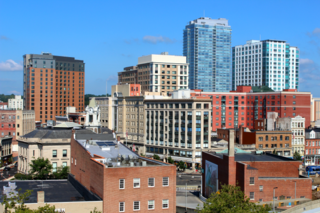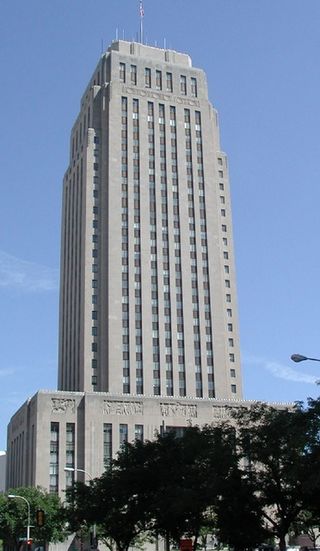
The Kansas City Star is a newspaper based in Kansas City, Missouri. Published since 1880, the paper is the recipient of eight Pulitzer Prizes. The Star is most notable for its influence on the career of President Harry S. Truman and as the newspaper where a young Ernest Hemingway honed his writing style. The paper is the major newspaper of the Kansas City metropolitan area and has widespread circulation in western Missouri and eastern Kansas.

Thomas Joseph Pendergast, also known as T. J. Pendergast, was an American political boss who controlled Kansas City and Jackson County, Missouri, from 1925 to 1939.

Lloyd Crow Stark was an American businessman and politician who served as the 39th Governor of the U.S. state of Missouri. He was a member of the Democratic Party.

Downtown Kansas City is the central business district (CBD) of Kansas City, Missouri and the Kansas City metropolitan area. It is between the Missouri River in the north, to 31st Street in the south; and from the Kansas–Missouri state line eastward to Bruce R. Watkins Drive as defined by the Downtown Council of Kansas City; the 2010 Greater Downtown Area Plan formulated by the City of Kansas City defines the Greater Downtown Area to be the city limits of North Kansas City and Missouri to the north, the Kansas–Missouri state line to the west, 31st Street to the south and Woodland Avenue to the east. However, the definition used by the Downtown Council is the most commonly accepted.

Quality Hill is a historic neighborhood near downtown Kansas City, Missouri, USA, on a 200-foot-high bluff which overlooks the confluence of the Kansas and Missouri rivers in the West Bottoms below.

The history of the Kansas City metropolitan area has records starting in the 19th century, as Frenchmen from St. Louis, Missouri moved up the Missouri River to trap for furs and trade with the Native Americans. The Kansas City metropolitan area, straddling the border between Missouri and Kansas at the confluence of the Kansas and Missouri Rivers, became a strategic point for commerce and security. Kansas City, Missouri was founded in 1838 and defeated its rival Westport to become the predominant city west of St. Louis. The area played a major role in the westward expansion of the United States. The Santa Fe, and Oregon trails ran through the area. In 1854, when Kansas was opened to Euro-American settlement, the Missouri-Kansas border became the first battlefield in the conflict in the American Civil War.

Ward Parkway is a boulevard in Kansas City, Missouri, United States, near the Kansas-Missouri state line. Ward Parkway begins at Brookside Boulevard on the eastern edge of the Country Club Plaza and continues westward along Brush Creek as U.S. Route 56 until it turns southward across the creek just before the Kansas-Missouri state line. It then continues south for four miles, terminating at Wornall Road near West 95th Street.

Downtown Stamford, or Stamford Downtown, is the central business district of the city of Stamford, Connecticut, United States. It includes major retail establishments, a shopping mall, a university campus, the headquarters of major corporations and Fortune 500 companies, as well as other retail businesses, hotels, restaurants, offices, entertainment venues and high-rise apartment buildings.

The Elms Hotel and Spa is a historic resort hotel at Regent and Elms Boulevard in Excelsior Springs, Missouri. It is listed on the National Register of Historic Places. It is located in The Elms Historic District.

Kansas City City Hall is the official seat of government for the city of Kansas City, Missouri. Located in downtown, it is a 29-story skyscraper with an observation deck. Completed in 1937, the building has a Beaux-Arts and Art-Deco style with numerous architectural features and ornamentation throughout. One Kansas City Place was modeled as a 1980s version of City Hall, and is the tallest building in Kansas City.

The Monroe Avenue Commercial Buildings, also known as the Monroe Block, is a historic district located along a block-and-a-half stretch at 16-118 Monroe Avenue in Detroit, Michigan, just off Woodward Avenue at the northern end of Campus Martius. The district was designated a Michigan State Historic Site in 1974 and listed on the National Register of Historic Places in 1975. The thirteen original buildings were built between 1852 and 1911 and ranged from two to five stories in height. The National Theatre, built in 1911, is the oldest surviving theatre in Detroit, a part of the city's original theatre district of the late 19th century, and the sole surviving structure from the original Monroe Avenue Commercial Buildings historic period.
The Tom Pendergast House is a historic residence located at 5650 Ward Parkway in the Country Club District in Kansas City, Missouri.
District I is the name of a historic district comprising five historic hotels in downtown Kansas City, Missouri listed on the National Register of Historic Places (NRHP) in 1983.

The Palm Beach Hotel, built in 1925 to replace an earlier building of the same name, is an historic four-story hotel located at 235-251 Sunrise Avenue in Palm Beach, Florida. Designed by architect Mortimer Dickerson Metcalfe in the Mediterranean Revival style, it was built by Thomas R. Clarke. In 1969 it became vacant and, except for several attempts to reopen it as a retirement hotel, it remained so until 1981 when it was converted into a condominium, the Palm Beach Hotel Condominium.

The Bell Apartments, also known as the Austin A. Bell Building is a historic building located at 2326 1st Avenue in the Belltown neighborhood of Seattle Washington. The building was named for Austin Americus Bell, son of one of Seattle's earliest pioneers, but built under the supervision of his wife Eva following Bell's unexpected suicide in 1889 soon after proposing the building. It was designed with a mix of Richardsonian, Gothic and Italianate design elements by notable northwest architect, Elmer Fisher, who designed many of Seattle's commercial buildings following the Great Seattle fire.

Gay Street is a street in Knoxville, Tennessee, United States, that traverses the heart of the city's downtown area. Since its development in the 1790s, Gay Street has served as the city's principal financial and commercial thoroughfare, and has played a primary role in the city's historical and cultural development. The street contains Knoxville's largest office buildings and oldest commercial structures. Several buildings on Gay Street have been listed on the National Register of Historic Places.

The Kansas City Club, founded in 1882 and located in the Library District of Downtown Kansas City, Missouri, USA, was the oldest gentlemen's club in Missouri. The club began admitting women members in 1975. Along with the River Club on nearby Quality Hill, it was one of two surviving private city clubs on the Missouri side of Kansas City. Notable members included Presidents Harry Truman and Dwight D. Eisenhower, General Omar Bradley, and political boss Tom Pendergast. It ceased operation in 2015.

The Ritz-Carlton Atlantic City, located at 199 S. Iowa Avenue in Atlantic City, New Jersey, began as a hotel on the Boardwalk in Atlantic City, built at the beginning of the Roaring Twenties and renowned for its luxurious decor and famous guests. It was used as an apartment hotel beginning in 1969, and then purchased in 1978 with the intention of developing it as a hotel and casino. The building was converted to The Ritz Condominiums in 1982.

Laura Street is a north–south street in Jacksonville, Florida, United States, named for the daughter of the city's founder, Isaiah D. Hart. Historically, the downtown portion of Laura Street has been considered the financial district of Jacksonville.

The Hartman Hotel is an condominium complex and former hotel and office building in Downtown Columbus, Ohio. The building was completed in 1898 and was listed on the National Register of Historic Places in 2018.




















